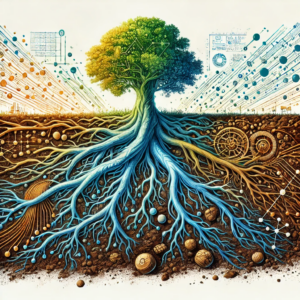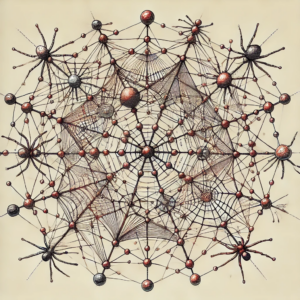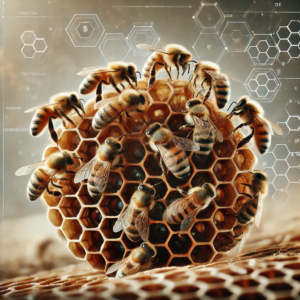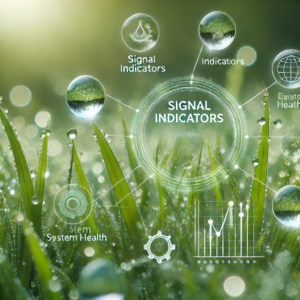Engineering a Better Economy: Why KEYSTONE-Based Technologies Matter More Than Ever
Introduction
What if we could engineer a global economy as resilient as nature itself—one that operates on principles of harmony, sustainability, and shared prosperity? In an era with rising economic uncertainty, there is an explosive growth of new technologies. And at the same time, trust in traditional economic systems appears to be eroding. The time has come for IEEE technical leaders to consider new paradigms and thought experiments. Enter the KEYSTONE framework, a concept built on nature-inspired values that offer an alternative to the current economic and financial systems that can serve as a case study for exploring thought experiments on new ideas and new systems as the growth of new technologies evolve.
KEYSTONE represents Knowledge, Effort (Energy), Yielding Security, Sustainability, Transparency, Open Access, Non-Negotiable Integrity, and Endurance. Not only does this acronym attempts to describe relatively new technologies such as Blockchain-Proof of Work (BC-PoW), and its implied values such that they are not just merely abstract ideals; they are the blueprint for designing and engineering systems that can withstand disruption and foster cooperation on a global scale.
Imagine an ecosystem where economies prioritize Mutually Assured Peace (MAP) over Mutually Assured Destruction (MAD).
This thought experiment invites us to explore how such a framework, grounded in the KEYSTONE principles and how it could reshape our economic landscape and create a more prosperous and peaceful world. It is also an attempt to experiment and apply KEYSTONE principles to serve as a case study and approach to meet Region 5 priorities. As understood and interpreted by this author from a STEM/STEAM perspective, these priorities are:
- Priority 1: Revitalize section leadership through mentorship and educational activities in STEM/STEAM, ideally facilitated by Life Member Affinity Group (LMAG) members mentoring Young Professionals (YP), YP mentoring Student Branches, and IEEE engineering students mentoring K-12 students through community and industry outreach.
- Priority 2: Strengthen the pipeline of Young Professionals from student branches using KEYSTONE principles of decentralization, responsibility, and reward for effort.
- Priority 3: With joint activities in STEM/STEAM, you can possibly increase industry engagement with KEYSTONE concepts to showcase the practical and ethical applications of technology while leveraging the use of AI.
Note that STEAM from this author’s perspective stands for
- S=Science
- T=Technology
- E=Engineering
- A=Art and science of applying artificial intelligence (AI) for multi-media communication and expression of STEM concepts
- M=Mathematics.
The acronym STEAM can also be rearranged as TEAMS, describing as a multi-disciplinary team approach for implementing and marketing STEM/STEAM educational activities that aligns with Region 5 priorities.
The AI images shown in this article serves as examples to illustrate the KEYSTONE principles such as decentralization, transparency and trust. We can also use AI to simplify KEYSTONE principles and adapt them for educational modules, tutorials, and simulations. AI can personalize learning experiences in STEM/STEAM fields, facilitating broader engagement.
In addition, Squishy Circuits exemplifies the KEYSTONE principles through a hands-on learning experience that mirrors natural processes, making it an excellent educational tool. The conductive and insulating doughs provide a tangible, visual way to understand and manipulate electric current, aligning with the 8 nature-inspired metaphors, as shown in a later section of this article.
The Case for Change: From MAD to MAP
In the current economic/financial landscape, fiat currencies operate in a model resembling Mutually Assured Destruction (MAD), where military and economic power is often maintained through competition, dominance, and, at times, manipulation. This system has inherent weaknesses: it’s vulnerable to inflation, susceptible to political instability, and dependent on the trust placed in centralized institutions. While this model has powered economies for centuries, it may not be the best model for fostering long-term global prosperity and peace.
In contrast, a MAP-based economy, such as that envisioned by KEYSTONE (like BC-PoW as an example) and similar decentralized ecosystems, seeks a mutually beneficial coexistence. MAP doesn’t imply an immediate overthrow of fiat economic systems; rather, it suggests a gradual evolution toward models that help prioritize transparency, sustainability, and inclusivity. With the KEYSTONE framework as a guide, we can start engineering and evolving towards an economy that echoes nature’s resilience, stability, and harmony.
KEYSTONE Principles: Building Blocks for a Resilient Economy
The KEYSTONE values are derived from systems found in nature, which excel at sustaining life, adapting to change, and balancing competing needs. By understanding each of these principles, IEEE leaders can glimpse the architecture of a better economic system—one that thrives on cooperation rather than competition. The following section attempts to clarify each letter with examples found in nature as well as relating to Squishy Circuits.
K: Knowledge
Knowledge is essential in both natural and economic systems. Nature constantly learns and adapts through evolution; likewise, a resilient financial ecosystem should prioritize continuous learning, transparency, and knowledge sharing. A MAP-based system, inspired by Bitcoin’s open-source protocol, decentralizes access to information. Every participant in this financial ecosystem has insight into transactions, value, and risk, creating a well-informed society less prone to exploitation.
In a KEYSTONE-driven economy, knowledge becomes decentralized, leading to an environment where innovation thrives, and fragile manipulation decreases. The focus on transparent, open-access knowledge cultivates an economy where every participant, regardless of position or resources, has the tools to make informed decisions.
As an example, found in nature, take a look at tree roots as knowledge networks. Tree roots spread through the soil to absorb nutrients, similar to how engineering knowledge is built through interconnected fields and shared understanding. Just as roots draw from diverse soil components, engineering solutions benefit from integrating cross-disciplinary insights.
In Squishy Circuits, the conductive dough is like tree roots, forming a network that connects different components, such as LEDs and motors, allowing the current to “flow” through the circuit, much like nutrients through a tree’s roots.
E: Effort (Energy)
Effort fuels growth in both ecosystems and economies. In nature, each organism invests in its environment, creating a balanced system that supports mutual survival. In the financial world, for example, Bitcoin’s proof-of-work (PoW) model requires effort and energy, using computational power to validate transactions and secure the network.
While PoW is energy-intensive, it incentivizes innovation in sustainable energy. By channeling effort into securing the network, we create a financial ecosystem where value is reinforced by real investment, mirroring the way organisms in an ecosystem invest energy for survival. Effort, as a KEYSTONE principle, ensures that only those willing to contribute to the system reap its rewards, thus preserving the integrity of the economy.
Building Hives as Continuous Effort: Bees build intricate hives by working collectively and tirelessly. Engineering projects similarly require sustained effort from individuals working together, each contributing to a larger structure.
Building a Squishy Circuit requires careful placement of conductive and insulating doughs, akin to bees constructing intricate hives. Each placement is an effort that cumulatively leads to a functioning circuit.
Y: Yielding Security
In nature, security is a byproduct of mutual dependence; organisms collectively contribute to the ecosystem’s stability. Similarly, in a MAP-based economy, security is achieved through decentralized validation. In contrast to traditional finance, which relies on central institutions as gatekeepers, a decentralized system like Bitcoin offers distributed security, reducing vulnerabilities.
Yielding security in the MAP model creates a financial system where no single entity controls the network, mirroring the “honeycomb effect” of nature—each participant reinforces the others, contributing to a self-sustaining network.
Spider Webs as Redundant Structures: A spider’s web has multiple connections and redundancies, making it resilient to damage. Engineering designs often incorporate redundancy to ensure security and reliability, even if one component fails.
 In Squishy Circuits, using more conductive dough or reinforcing certain areas can ensure better stability and current flow, similar to how spiders build redundancies into their webs for resilience.
In Squishy Circuits, using more conductive dough or reinforcing certain areas can ensure better stability and current flow, similar to how spiders build redundancies into their webs for resilience.
S: Sustainability
Sustainability is a principle that nature embodies effortlessly. Resources are used and recycled efficiently to support future generations. Consider the Bitcoin’s model, while often critiqued for energy use, has led to innovations in renewable energy consumption. By encouraging miners to seek the most cost-effective energy sources, Bitcoin aligns financial incentives with sustainable practices.
A KEYSTONE-based financial system, then, supports not just the present but also the future. Emerging technologies like Layer 2 solutions (e.g., the Lightning Network) reduce energy demands while maintaining security, paving the way for a sustainable economy without compromising the planet’s resources.
Wolves in Ecosystems as Natural Balancers: Wolves maintain ecological balance by controlling prey populations. In engineering, feedback systems regulate and sustain stability, keeping systems from overloading or deteriorating.
In a Squishy Circuit, insulating dough acts as a balancing factor, preventing current from flowing where it shouldn’t. This balance is akin to wolves in ecosystems, who keep prey populations in check.
T: Transparency
Nature operates transparently, with every organism’s role visible and understood. This open access to resources maintains a balance where no single species dominates at the expense of others. In the MAP framework, Bitcoin’s public ledger provides an unprecedented level of transparency in financial transactions, enabling accountability and building trust.
Transparency in the MAP system empowers participants, reducing the need for middlemen and creating a system of accountability. Unlike centralized fiat systems, where decision-making can often be opaque, a transparent economic system provides an equal playing field for all participants.
Dew on Grass as Signal Indicators: Dew reflects the health of the environment, indicating humidity or temperature. In engineering, transparency manifests as dashboards or indicators that reveal system health and provide feedback to users.
LEDs lighting up in Squishy Circuits serve as indicators of current flow, providing immediate feedback on whether the circuit is functioning correctly, much like dew indicates environmental conditions.
O: Open Access
Nature thrives through diversity and inclusivity, where each organism has a role in the ecosystem. Similarly, open access is vital to a just and inclusive financial system. In a MAP-based system, anyone with a smartphone and internet connection can participate, regardless of nationality or economic status.
Open access democratizes finance, eliminating barriers and giving individuals in underserved regions opportunities to participate in the global economy. This inclusivity can drive economic growth and innovation worldwide, reshaping the global economic landscape.
Forest Mycorrhizal Networks as Resource Sharing: Trees share resources through mycorrhizal fungi networks, benefiting each other in a mutually accessible system. Engineers design open-access systems that share data or resources to promote collaborative growth and innovation.
This image portrays a vibrant forest scene with a diverse group of trees connected through a web of glowing, intricate fungal networks at their roots. These connections symbolize the shared flow of resources, reflecting how trees in nature support one another. Engineers, standing nearby with blueprints and tools, examine the network thoughtfully, underscoring how open-access systems inspired by natural networks promote mutual benefit, growth, and collaboration.
Squishy Circuits make electronics accessible to a wider audience, encouraging open learning and resource sharing. Anyone can use the conductive dough to create circuits, democratizing access to electronics knowledge.
N: Non-Negotiable Integrity
Integrity is non-negotiable in both natural and financial systems. In nature, every organism’s contribution is essential to the ecosystem’s health; any failure could cause the entire system to suffer. For example, Bitcoin’s decentralized model ensures that no single entity can manipulate the system without consensus.
Non-negotiable integrity is the backbone of the MAP economy. By preventing tampering and manipulation, decentralized networks offer a stable foundation for a trustworthy and reliable financial system. Integrity, as a KEYSTONE value, fosters a financial ecosystem where honesty and fairness are embedded in the system’s very structure.
DNA in Living Organisms as an Unchanging Code: DNA maintains the integrity of life by passing accurate information across generations. Similarly, engineers rely on foundational principles that provide consistent guidance for design and development.
The function of Squishy Circuits is based on consistent rules of electricity. This integrity in design and function allows users to rely on fundamental concepts, as DNA reliably codes for life.
E: Endurance
Endurance represents the ability to adapt, grow, and sustain. In nature, ecosystems survive and thrive through continuous evolution, balancing immediate needs with long-term goals. Bitcoin’s design encourages holding and building long-term value rather than promoting a culture of instant gratification.
Endurance is the ultimate goal of a MAP-based financial system. By prioritizing patience and stability, this system aligns incentives toward enduring prosperity, fostering an economy that grows rather than collapses.
Mountain Ranges as Resilient Structures: Mountains withstand weathering and erosion over centuries, much like engineering structures must endure various stresses over time to remain functional and safe.
The principles learned through Squishy Circuits form an enduring foundation for understanding more complex electronics. These basic concepts are resilient and applicable to more advanced topics.
Toward a MAP Economy: Integrating KEYSTONE Principles in Technologies
A MAP-based economy doesn’t necessitate a wholesale replacement of fiat systems. Instead, it envisions a cooperative model where decentralized systems and traditional financial systems coexist. The MAP approach allows for gradual integration, where Bitcoin and fiat can complement one another by harnessing the strengths of both.
Bitcoin can function as a store of value, providing a decentralized and secure alternative to fiat currency, while fiat systems continue to serve as mediums of exchange. This hybrid system combines the transparency, security, and inclusivity of MAP with the familiarity and accessibility of fiat, resulting in a financial world engineered for resilience and long-term prosperity.
Conclusion: A Blueprint for Shaping Future Economies
For IEEE technical leaders, the KEYSTONE framework offers a roadmap for transforming the financial landscape into a more resilient, transparent, and inclusive system. By drawing inspiration from nature’s most successful ecosystems, we can create an economy that not only generates wealth but also supports sustainable growth and cooperation.
The future of finance isn’t solely about accumulating wealth; it’s about creating a system that empowers individuals, promotes trust, and fosters global prosperity. With the KEYSTONE framework guiding us, the MAP approach offers a vision for an economic/financial ecosystem that aligns with human values and nature’s inherent wisdom. As we engineer a better economy, one inspired by the resilience of natural systems, we lay the foundation for a future defined not by scarcity or competition, but by abundance and collaboration.
The AI image shown below attempts to illustrate and describe the KEYSTONE framework visually by integrating symbols for each principle within a harmonious, nature-inspired composition. The overall design merges organic forms with a touch of futuristic style, capturing the concept of an economy inspired by nature’s resilience and technological innovation.
- Knowledge is represented by a network of interconnected, glowing nodes, suggesting shared learning and transparency.
- Effort is symbolized through flowing elements resembling water or gears, capturing the essence of continuous energy investment.
- Yielding Security appears as a honeycomb pattern, symbolizing decentralized strength and community resilience.
- Sustainability is depicted by vibrant greenery and a central tree, representing growth and renewal.
- Transparency is conveyed through clear, open structures, suggesting openness and accessibility.
- Open Access includes interconnected hands or a global shape, emphasizing inclusivity and connectivity.
- Non-Negotiable Integrity takes the form of a mountain or solid structure, portraying stability and unbreakable principles.
- Endurance is illustrated by a robust oak tree or concentric growth rings, symbolizing resilience and adaptability.
Author’s Notes and Further Reading
The ‘what-if or thought experiment’ articles below are attempts to make blockchain and bitcoin more understandable by relating it to natural laws found in nature so that we can develop systems like the ones found in nature that are resilient and are found to have interactive relationships of system of ecosystems. His insights on nature and technology are based on his 26-years of dealing with various technologies, such as directed energy systems and precision-guided munitions. His insights were also from his international experience with setting up a large number of technical workshops and conferences while stationed at the European Office of Aerospace Research and Defense (EOARD) under the Air Force Office of Scientific Research (AFOSR). There he was a Deputy Commander, Chief Scientist/Technical Director, working jointly with similar technical agencies of the Army, Navy and Air Force Research Laboratories in the United States. His additional duties include being the IT technology manager for the Tri-Service organization as well as being the point-of-contact for Electrical and Computer Engineering applications.To delve deeper into how KEYSTONE principles can reshape the global economy, IEEE members may find these resources insightful:
- IEEE Blockchain Standards: https://blockchain.ieee.org/
- “Bitcoin: A Peer-to-Peer Electronic Cash System” by Satoshi Nakamoto
- This article/post was inspired by the YouTube interviews with Michael Saylor, Jason Lowery, Saifedeen Ammous, and Robert Breedlove. The author has curated these video playlists at Blockchain Technology | IEEE Pikes Peak Section
- The webpage contains tabbed resources about blockchain applications and its profound implications.
- Please contact Dr. John Santiago if you are interested in learning more about this ground-breaking and paradigm shifting technologies.
- The mini-site webpage has a rough draft of a STEM/STEAM strategic plan (work-in-progress) and other documents to implement KEYSTONE principles and other ideas, including squishy circuits resources from IEEE in the future
- Trump’s Administration Will Impact AI, Energy, Crypto and More – IEEE Spectrum








